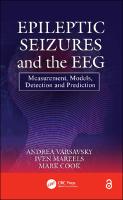Epileptic Seizures and the EEG
Proposal review
Measurement, models, detection and prediction
| dc.contributor.author | Varsavsky, Andrea | |
| dc.contributor.author | Mareels, Iven | |
| dc.contributor.author | Cook, Mark | |
| dc.date.accessioned | 2020-07-23T15:33:59Z | |
| dc.date.available | 2020-07-23T15:33:59Z | |
| dc.date.issued | 2010 | |
| dc.identifier | ONIX_20200723_9781439812006_10 | |
| dc.identifier | OCN: 769189667 | |
| dc.identifier.uri | https://library.oapen.org/handle/20.500.12657/40058 | |
| dc.description.abstract | Analysis of medical data using engineering tools is a rapidly growing area, both in research and in industry, yet few texts exist that address the problem from an interdisciplinary perspective. Epileptic Seizures and the EEG: Measurement, Models, Detection and Prediction brings together biology and engineering practices and identifies the aspects of the field that are most important to the analysis of epilepsy. Analysis of EEG records The book begins by summarizing the physiology and the fundamental ideas behind the measurement, analysis and modeling of the epileptic brain. It introduces the EEG as a measured signal and explains its use in the study of epilepsy. Next, it provides an explanation of the type of brain activity likely to register in EEG measurements, offering quantitative analysis of the populations of neurons that contribute to both scalp and cortical EEG and discussing the limitations and effects that choices made in the recording process have on the data. The book provides an overview of how these EEG records are and have been analyzed in the past, concentrating on the mathematics relevant to the problem of classification of EEG. The authors use these extracted features to differentiate between or classify inter-seizure, pre-seizure and seizure EEG. The challenge of seizure prediction The book focuses on the problem of seizure detection and surveys the physiologically based dynamic models of brain activity. Finally, the book addresses the fundamental question: can seizures be predicted? Through analysis of epileptic activity spanning from 3 hours to 25 years, it is proposed that seizures may be predictable, but the amount of data required is greater than previously thought. Based on the authors’ extensive research, the book concludes by exploring a range of future possibilities in seizure prediction. | |
| dc.language | English | |
| dc.subject.classification | thema EDItEUR::M Medicine and Nursing::MF Pre-clinical medicine: basic sciences | en_US |
| dc.subject.classification | thema EDItEUR::P Mathematics and Science::PS Biology, life sciences::PSA Life sciences: general issues::PSAN Neurosciences | en_US |
| dc.subject.classification | thema EDItEUR::M Medicine and Nursing::MQ Nursing and ancillary services::MQW Biomedical engineering | en_US |
| dc.subject.other | Detection | |
| dc.subject.other | EEG | |
| dc.subject.other | Epileptic | |
| dc.subject.other | Measurement | |
| dc.subject.other | Models | |
| dc.title | Epileptic Seizures and the EEG | |
| dc.title.alternative | Measurement, models, detection and prediction | |
| dc.type | book | |
| oapen.identifier.doi | 10.1201/b10459 | |
| oapen.relation.isPublishedBy | 7b3c7b10-5b1e-40b3-860e-c6dd5197f0bb | |
| oapen.imprint | CRC Press | |
| oapen.pages | 369 | |
| peerreview.anonymity | Single-anonymised | |
| peerreview.id | bc80075c-96cc-4740-a9f3-a234bc2598f1 | |
| peerreview.open.review | No | |
| peerreview.publish.responsibility | Publisher | |
| peerreview.review.stage | Pre-publication | |
| peerreview.review.type | Proposal | |
| peerreview.reviewer.type | Internal editor | |
| peerreview.reviewer.type | External peer reviewer | |
| peerreview.title | Proposal review | |
| oapen.review.comments | Taylor & Francis open access titles are reviewed as a minimum at proposal stage by at least two external peer reviewers and an internal editor (additional reviews may be sought and additional content reviewed as required). |

